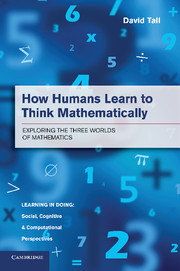Book contents
- Frontmatter
- Dedication
- Contents
- Series Foreword
- Journeys through three worlds of mathematics
- Preface
- Acknowledgements
- Illustration Credits
- I Prelude
- II School Mathematics and Its Consequences
- 2 The Foundations of Mathematical Thinking
- 3 Compression, Connection and Blending of Mathematical Ideas
- 4 Set-Befores, Met-Befores and Long-Term Learning
- 5 Mathematics and Emotion
- 6 The Three Worlds of Mathematics
- 7 Journeys through Embodiment and Symbolism
- 8 Problem Solving and Proof
- III Interlude
- IV University Mathematics and Beyond
- Appendix Where It All Came From
- References
- Index
3 - Compression, Connection and Blending of Mathematical Ideas
from II - School Mathematics and Its Consequences
Published online by Cambridge University Press: 05 June 2014
- Frontmatter
- Dedication
- Contents
- Series Foreword
- Journeys through three worlds of mathematics
- Preface
- Acknowledgements
- Illustration Credits
- I Prelude
- II School Mathematics and Its Consequences
- 2 The Foundations of Mathematical Thinking
- 3 Compression, Connection and Blending of Mathematical Ideas
- 4 Set-Befores, Met-Befores and Long-Term Learning
- 5 Mathematics and Emotion
- 6 The Three Worlds of Mathematics
- 7 Journeys through Embodiment and Symbolism
- 8 Problem Solving and Proof
- III Interlude
- IV University Mathematics and Beyond
- Appendix Where It All Came From
- References
- Index
Summary
In this chapter we consider the development of more sophisticated mathematical thinking through mental compression into thinkable concepts and connection between them to build knowledge structures that can be blended together to offer more sophisticated ways of thinking. The climax of mathematical thinking occurs with the formation of crystalline concepts that have a built-in structure of internal relationships.
Compression of knowledge is essential to enable us to make sense of complicated situations. We compress time and distance to a human scale. We compare events that happened years apart by recalling them and talking about them at will. We speak easily of millions of years of evolution, or of light-years of distance to another galaxy in the universe. We imagine tiny parts of matter far smaller than we can see – molecules, atoms, quarks – and we imagine tiny fractions of a second that we cannot sense in real time. All of these mysteries of our imagination use our extended awareness to take us beyond our physical confinement in time and space to enable us to think in highly sophisticated ways.
In this chapter we introduce three major methods of compression using categorization based on recognition, encapsulation based on repeating actions that are symbolized and can be manipulated as mental entities and definition that uses language to formulate a specific concept in a given context. We will i nd that definitions in mathematics occur in different ways: as Euclidean definitions of observed figures, as definitions of observed properties of numbers and arithmetic, and as more general set-theoretic definitions as the basis of more formal mathematical thinking.
- Type
- Chapter
- Information
- How Humans Learn to Think MathematicallyExploring the Three Worlds of Mathematics, pp. 50 - 83Publisher: Cambridge University PressPrint publication year: 2013



